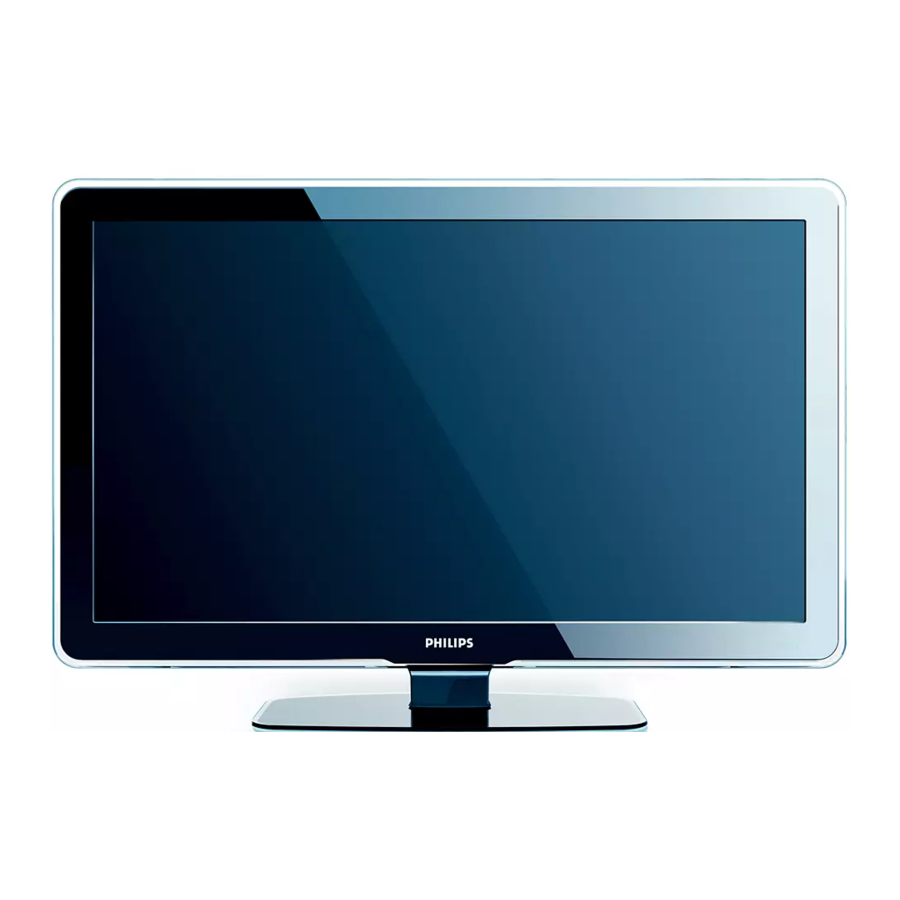Summarization of Contents
Overview of television controls and connectors
Side controls
Details on volume, menu, channel, and power buttons on the TV.
Side connectors
Ports for connecting mobile devices or headphones on the side.
Rear connectors
Ports for antenna and permanent devices like DVD players or VCRs.
Get started
Position the TV
Guidance on optimal TV placement for viewing and Ambilight.
Install the remote control batteries
Instructions for inserting batteries into the remote control.
Use the Source List
How to select audio and video sources for connected devices.
Wall-mount the TV
Instructions and warnings for mounting the TV on a wall.
Secure the VESA-compatible wall bracket to the TV
Steps to attach a VESA bracket to the TV for wall mounting.
Select your location
Guide to choosing between Home and Shop mode for TV setup.
Select your on-screen menu language (TV mode only)
How to set the language for the TV's on-screen menus.
Manual installation
Change the Tuner Mode
How to select the TV tuner mode (Auto, Antenna, Cable).
Change the TV System
How to set the TV's broadcast system (NTSC, PAL-M, PAL-N).
Fine tune your channels
Adjusting channel reception for optimal clarity.
Use the Advance Picture features
Use Contrast +
Optimizing picture contrast for overall quality.
Use Active Control
Intelligent adjustment of picture quality based on incoming signal.
Active Control settings
Explains the options for Active Control: Off, On, and On + Light Sensor.
Use the timer
Set the sleeptimer
Setting the TV to switch to standby after a specified period.
Set the TV time
Setting the current time on the TV.
Setting the TV timer
Configuring scheduled turn-on or channel changes.
Child-lock the TV
Enable Child Lock
How to activate the child lock feature to restrict access.
Disable Child Lock
How to deactivate the child lock feature.
Control access to TV channels
Access Parental Lock
Initial setup for parental controls, including setting an access code.
Change Access Code
Procedure to change the existing parental control access code.
Lock channels
How to individually lock specific TV channels.
Lock all channels
Method to lock all available TV channels simultaneously.
Unlock all channels
Procedure to unlock all previously locked TV channels.
Control access to TV programs
Use the movie rating lock (for certain regions only)
Blocking movies based on MPAA content ratings.
Use the TV Rating lock (For certain regions only)
Blocking TV programs based on age and content ratings.
Unblock programs
How to disable program blocking options.
Block other programs
Blocking unrated or programs with no advisory data.
Use the Surf feature
Add channels to your Surf list
Adding favorite channels to the Surf list for quick access.
Remove channels from Surf list
Removing channels from the Surf list.
Use your TV as a computer monitor
Picture settings (VGA mode)
Adjusting picture parameters when using the TV as a monitor.
Feature settings (VGA mode)
Setting TV features like Phase/Clock and Auto Adjust for PC input.
Use your TV in High Definition mode
Connect the HD equipment
Steps to connect HD devices via HDMI or DVI.
Control the TV settings in HD mode
Adjusting picture, sound, and feature settings for HD content.
Use Mode Selection (For 480p, 720p and 1080p formats only)
Selecting PC or HD mode for specific resolutions.
Use Philips EasyLink
Utilizing HDMI-CEC for controlling connected devices.
One-touch play
Automatically switching to the correct input for connected devices.
One-touch Standby
Putting connected devices into standby using the TV remote.
Connect devices
Connection overview
Visual guide to all TV input/output ports and their functions.












Need help?
Do you have a question about the 32PFL5403/78 and is the answer not in the manual?
Questions and answers